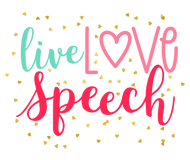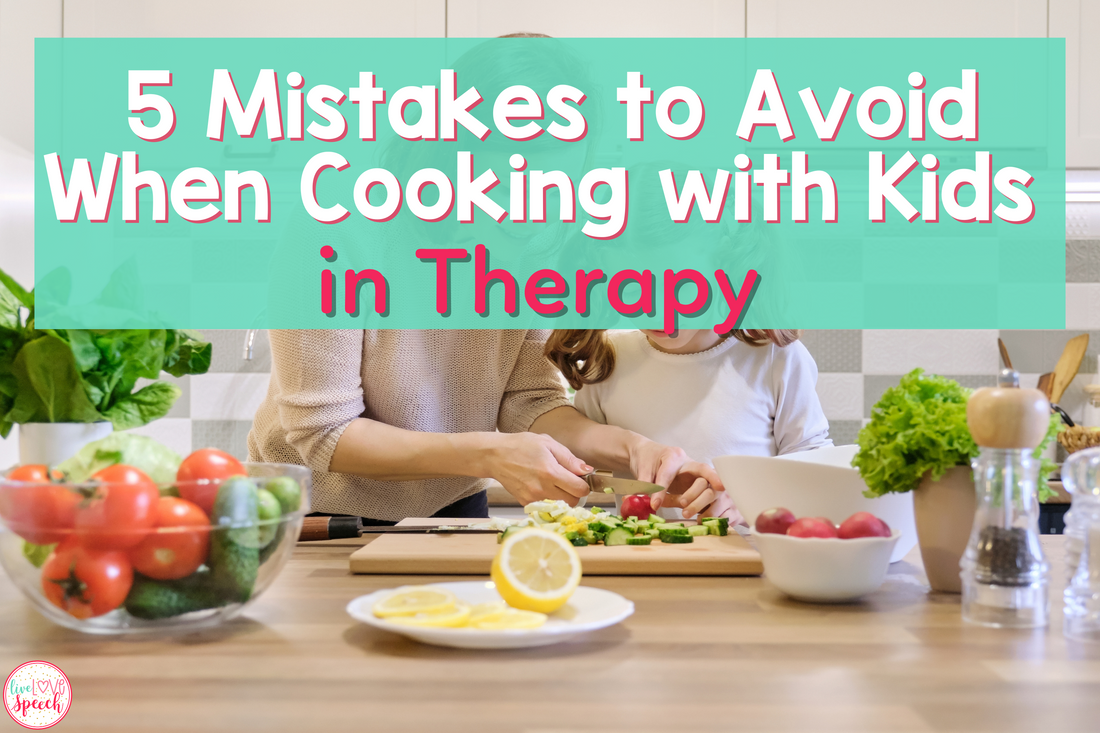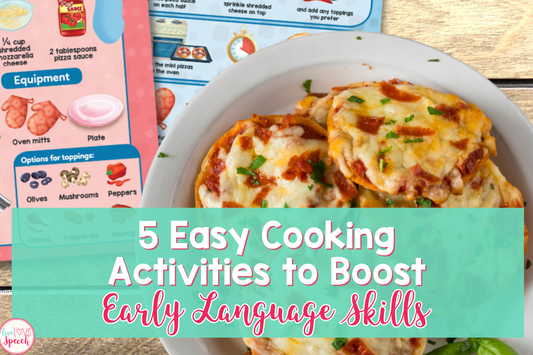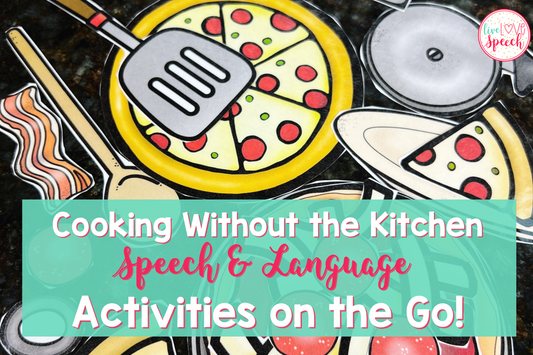
Cooking with kids? Easy? Nope. But rewarding? Heck yes! As an SLP and a mom to my little kitchen sidekick, Landon, I’ve seen firsthand how cooking builds confidence, strengthens fine motor skills, and encourages communication. It’s pretty amazing to watch kids light up when they mix, measure, and create something of their own. With that said, there are definitely a few bumps along the way. From recipes that are way too complicated to forgetting simple safety steps, I’ve made my fair share of mistakes (hello, flour explosion).
The good news? These common mistakes are easy to fix with a little prep and some thoughtful tweaks. Whether you’re whipping up play food or creating a simple no-bake snack in therapy, avoiding these pitfalls will help you get the most out of every session.
Let’s talk about the five mistakes to avoid and the simple solutions that will make cooking with kids more effective and enjoyable.
Cooking with Kids Mistakes to Avoid
1. Choosing Recipes That Are Too Complicated
Mistake:
It’s tempting to pick fun, Pinterest-worthy recipes, but when the steps are too complex, kids can lose interest or get overwhelmed. Long ingredient lists or tricky techniques can steal focus from the therapy goals.
Easy Fix:
Stick to simple, age-appropriate recipes with clear, manageable steps. Think fruit kabobs, trail mix, or easy no-bake snacks. These types of recipes keep kids engaged and allow you to focus on building speech, language, and motor skills without the stress of complicated cooking. Plus, fewer steps mean fewer meltdowns, trust me, I’ve learned the hard way.
Need a foolproof, kid-friendly recipe?
Try my S’mores on a Stick Visual Recipe! It’s a fun, no-bake activity that lets kids practice sequencing, following directions, and building vocabulary. Plus, the visual recipe makes it easy for kids to follow along independently, making it perfect for therapy sessions. Plus, it's FREE! Click here to grab your visual recipe.
2. Skipping Pre-Session Prep
Mistake:
You know that chaotic moment when you’re scrambling to find a missing measuring cup while a group of kids is staring at you? Been there. Forgetting to pre-measure ingredients or set out tools in advance can lead to long wait times, which makes kids lose focus fast. Plus, you’ll be spending more time on logistics than on targeting therapy goals.
Easy Fix:
Do the prep work ahead of time. Pre-chop ingredients, portion out items, and organize your tools before the session starts. This allows you to dive right into the interactive, skill-building parts of the activity that keeps kids engaged and on task. Bonus tip: At home, I let Landon help with the easy prep work. It gives him a sense of ownership and keeps his little hands busy.
Want to make your prep even smoother?
Check out my Top 10 Must-Have Tools for Cooking with Kids blog post! These kid-friendly kitchen tools make cooking safer, easier, and way more fun, whether you’re chopping, mixing, or measuring. Trust me, having the right tools on hand will save you time and stress during your sessions!

3. Ignoring Safety Precautions
Mistake:
It’s easy to get caught up in the fun of cooking and forget basic safety measures. Whether it’s handling sharp objects, hot surfaces, or just keeping things clean, skipping safety steps can lead to accidental ouchies or messy mishaps.
Easy Fix:
Take a minute to review basic kitchen safety before diving into the recipe. Teach kids how to hold utensils properly, explain the dangers of hot surfaces, and emphasize handwashing. When I’m cooking with Landon, we always review safety first because honestly, I’d rather have fewer spills and no tears.
Want more safety tips?
Check out my Cooking Safety Tips for Kids blog post! It’s packed with practical, kid-friendly safety strategies that will help you keep cooking sessions fun, safe, and stress-free. Whether you’re working on cutting skills, heat safety, or cleanliness, this guide has you covered!

4. Overwhelming Kids with Multiple Tasks
Mistake:
I’ve definitely been guilty of this one. It’s easy to pile on too many steps at once, thinking kids can handle it all. But when they’re measuring, stirring, and assembling all at the same time, it can lead to confusion, frustration, and a whole lot of "I can’t do it!" moments.
Easy Fix:
Slow it down. Break the recipe into small, manageable steps. For example, have one child measure ingredients, another stir the mixture, and a third assemble the final product. Focusing on one skill at a time makes the process more structured and less overwhelming. At home, I let Landon tackle one simple task before moving on because when he feels successful, he stays engaged.
Looking for an easy way to assign tasks?
My Visual Recipes make it simple to divide up responsibilities during cooking sessions. Each step is clearly illustrated so kids can see exactly what task they’re doing. This makes it easier to delegate and keep everyone on track, while also boosting independence and confidence in the kitchen!
 5. Not Tying Activities to Therapy Goals
5. Not Tying Activities to Therapy Goals
Mistake:
It’s easy to get caught up in the fun of cooking (especially when you have an eager little helper), but in therapy sessions, it’s important to be intentional. If you’re not actively connecting the tasks to your therapy objectives, the session misses its full potential.
Easy Fix:
Be goal-oriented from the start. Before you begin, identify the specific skills you want to target.
-
For language development: Focus on sequencing steps, expanding vocabulary, and practicing descriptive language.
-
For motor skills: Incorporate tasks like stirring, scooping, and pinching to build fine motor strength.
-
For social skills: Use the activity to practice turn-taking, making requests, and working collaboratively.

By tying each task to a goal, you’ll make your cooking sessions more impactful and purposeful for your students.
Make Cooking with Kids in Therapy Count
Cooking with kids in therapy doesn’t have to be overwhelming. With a little prep and a focus on therapy goals, you can create sessions that are fun, meaningful, and packed with learning opportunities.
Try it!!! You won’t regret it. Watching your kids gain confidence while stirring, measuring, and mixing is truly rewarding. Plus, you’ll be helping them build essential skills that go far beyond the kitchen.
Want more cooking tips for therapy?
Check out my Beginner’s Guide to Cooking with Kids in Therapy Sessions for even more ideas on how to make cooking a valuable part of your therapy routine!
Check out my other blog posts for more creative and practical therapy ideas, and for even more ways to start cooking with kids! Happy cooking and learning! 🎉






